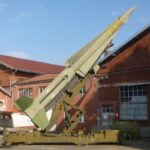The MIM-14 Nike Hercules was a surface-to-air missile (SAM) used by U.S. and NATO armed forces for high-altitude long-range air defense. It was normally armed with the W-31 nuclear warhead, but could also be fitted with a conventional warhead. Hercules was originally developed to carry a nuclear warhead in order to defeat entire formations of high-altitude supersonic targets. It had two solid fuel stages that provided three times the range of the previous Nike Ajax. Service began in 1958 and at its peck, it was deployed at over 130 bases in the US alone. Hercules remained the US primary heavy SAM until it began to be replaced by the higher performance and considerably more mobile MIM-104 Patriot in the 1980s. Patriot’s much higher accuracy allowed it to dispense with the nuclear warhead, and Hercules was the last US SAM to use this option. The last Hercules missiles were deactivated in Europe in 1998, fortunately without ever being fired in anger. In Italy the deployment of the Hercules begun in 1959 with the 1st Interceptors Brigade, composed by 3 Squadrons each made of 4 Croup, all of them situated in the North-East side of Italy, close to the Yugoslavian border of the “Iron Curtain”, in the direction of a potential Warsaw Pact attack. 96 launch ramps were deployed and more than 500 missiles supplied, many with nuclear warheads controlled directly by US troops. By 1998 the whole organization was disbanded and the very last Hercules missile was (probably) launched at the Italian experimental missile test range of Salto di Quirra in 2005. Volandia’s Nike Hercules was presentad by the Italian Air Force in 2018.
Western Helectric Nike Hercules
Aircrafts

Technical Specifications
Name :
MIM-14 Nike Hercules
Family :
SAM Missile
Manufacturer :
Western Electric
Nation :
USA
Production Year :
1958
Dimensions
Length :
12.65 m
Span :
3.50 m
Weights
Maximum Take-off :
4845 kg
Engines
4 Boosters M-42 and 1 sustainer Thiokol M-30
80000 kg Thrust / 3.4 sec + 500 kg Thrust / 29 sec
Performances
Maximum Speed :
4322 km/h
Range :
140 km
Cealing :
30000 m
History



